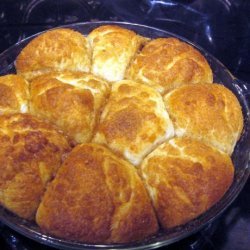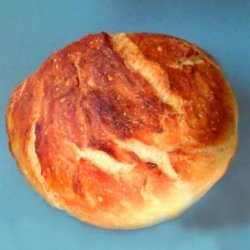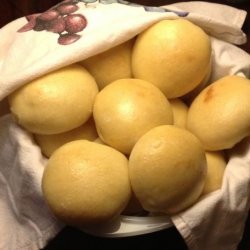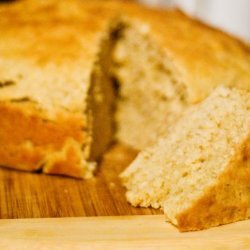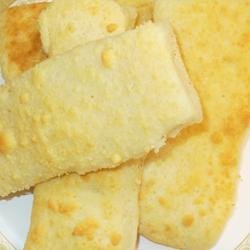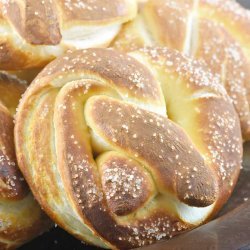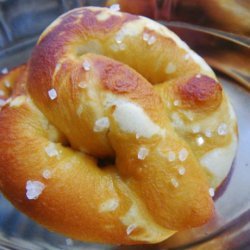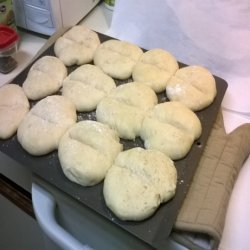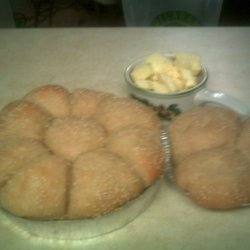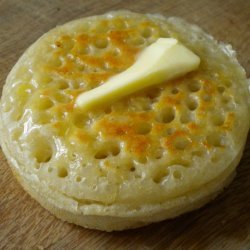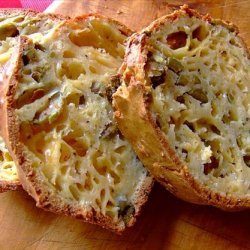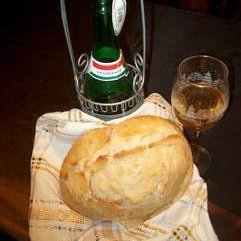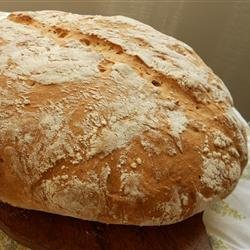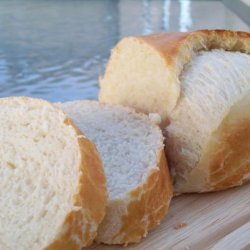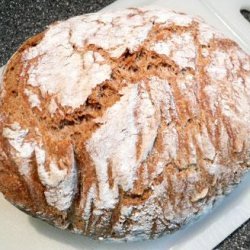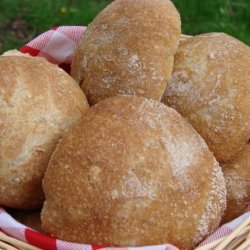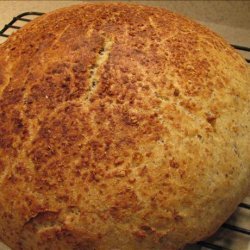Ingredients:
- 12 -13 fl oz water (415 ml, original recipe said 1 5/8ths cup, which was extremely difficult to get right)
Directions:
- *** Since first making this bread according to the original instructions (which caused a lot of mess), I've simplified the process. I have now bought a fairly deep plastic bowl with sloping edges, so it has a smallish bottom. The plastic seems almost - not quite - non-stick, and this is the method I use now:.
- In such a lightly greased plastic bowl, put the flour, and add the yeast, sugar and salt. You may want to add less salt, but we found the original amount (1 1/4 teaspoon) not enough. Mix through.
- Add the water and stir the lot through until well mixed to a nice, smooth, quite sloppy dough.
- Cover bowl with plastic wrap and put a kitchen terry towel or two over the top as well. Stand in a draught-free place for 18 hours.
- For me it works best to mix this up at 3pm. This means the dough is ready at 9am the next morning and I don't even have to get up early like my grandmother did to bake those huge farm loaves in the old days.
- After 18 hours the dough should be puffy and have little bubble holes on top and have more or less doubled in size, but don't worry too much about that.
- Instead of - as the original recipe said - turning out the dough on to a towel, do the following: From the sides of the bowl, scrape the dough away with light movements and fold it over on itself with floury fingers. Turn the bowl round and round, flattening the dough by repeating this folding over . LIGHTLY press a little flatter.
- Cover bowl with same (now messy) plastic used before, and same terry towels.
- Leave to rise again - 2 hours long.
- Half an hour before the 2 hours are up, put your oven on 450 deg F/220 deg Celsius. (I find that in my convection - fan - oven I can use a slightly lower heat: 215 - 210C, but the difference is not important).
- At the same time you need a heavy pot WITH a fitting lid, and this will go into the cold, heating-up oven, empty. The lid is to keep in the steam and cause that wonderful crust to form.
- Nothing beats an iron pot. Le Creuset will do too, and ceramic has been mentioned.
- I use a non-stick oval-shaped iron pot with a domed lid. You do NOT need a 6 - 8 quart pot (sounds crazy to me) as stated in the original recipe. It's a small bread. My iron pot is a 2 1/2 quart pot, which translates to roughly 2 1/2 litres as well.
- I grease the pot and lid with REAL butter, and sometimes I slosh in some olive oil. I don't know why, but I feel I should do it. Now PUT THE POT IN THE OVEN, lid on.
- After the 2 hours of the 2nd rising, and when the oven and pot has reached its correct heat, take out that piping hot pot very carefully (I put it on one of my oven grids on a granite surface next to the oven).
- Have the covered dough nearby, and a silicone or other spatula. Tilt the plastic bowl over the smoking pot (don't let it touch the very hot pot) and with spatula or fingers scrape the dough lightly and evenly into the hot pot. It will sizzle as it falls into the pot; don't worry about that.
- Shake the pot slightly to distribute the dough, put on the lid, and carefully shove the whole shebang into the hot oven.
- Bake 30 minutes with lid, then open oven and take off lid. Bake 15 - 30 minutes more, until your bread has a golden crust. I find that about 15 - 20 minutes after taking off the lid the bread is ready. Baking times will differ because ovens differ.
- Turn out, and swallow that saliva until it's just cooled enough so you can saw off the end part to eat with real butter. On your own.
- When cold, do not put in plastic bag. Use a paper bag at most. I simply turn it on to the cut side on the breadboard, and cover it with a kitchen towel. It lasts until it's been eaten, which doesn't take long. Do not refrigerate, which would be silly.
- ***A few points: 1. Z-mail me for questions 2. Your experience might be messier than mine; it depends on the consistency of the dough and the bowl you use. But greasing the bowl right at the start does help. 3. Keep to the hours mentioned. It's meant to be a sloooow rising process. 4. Be careful not to burn yourself! 5.I have just found, praise the angels, a wonderful, very fine stone-milled 100% organic flour, and have just put a loaf of that, for the first time, in the oven! I think this robust, Frenchified loaf just cries out for stone-milled flour, fine and creamy or almost white. 6. You could use 2 1/2 cups white bread flour + 1/2 cup fine rye flour. DO NOT USE wholewheat flour for this bread, except for maybe a handful: it does not have enough gluten for this bread.
- Good luck!
- And a warning, added months later: that pot you use MUST go into the oven empty, and must heat to the heat of the oven. I tried putting the dough in a cold pot yesterday, and the bread wasn't as successful. It didn't rise nearly as much, and didn't have that lovely artisanal cracked round top. So HEAT THE POT as instructed.
- MAKING A LARGER LOAF: The warning here is that I use my metric cups and spoons for this, which are very accurate! Fortunately I have a Pyrex measuring cup with both metric millilitres and Imperial fluid ounces, so I could measure the water absolutely equally.
- 4 x 250 ml flour, or 1 litre or 4 cups (1 quart).
- 3/4 teaspoon yeast, and stir into flour.
- 3/4 teaspoon sugar, stir into flour.
- 15 ml or 3 teaspoons salt.
- 600 ml or 19 fluid oz water (JUST under 2 1/2 American cups - maybe 2 teaspoons less than 2 1/2 cups).
- (EDITED June 2008): My husband actually calculated - I'm bad with maths! - that the water should be 666 ml - so add a dash more than 600 ml if you feel it's necessary. Just remember to bake this 2nd, larger recipe for the full hour. Also, he said the bread needed more salt. We don't eat a lot of salt and I'm not worried about the issue, so I now use 4 teaspoons, i.e. 1 tablespoon + 1 teaspoon).
- Best results are still with white bread flour, stone-milled, or all-purpose, and a little rye flour can be used too.
- Carry on as usual, grease the pot really well or pour some melted butter or olive oil into the hot pot and tilt it to grease bottom. By the way, a silicone spatula works a treat when you tilt the dough into the super-hot pot!
- YET ANOTHER NOTE: the 3-cup-flour bread is ready at plus-minus 45 minutes. I have found that the 4-cup-bread needs a full hour.
Nutrition Facts
| Amount Per 1 Serving | |||
| Calories | 62.26 Kcal (261 kJ) | ||
| Calories from fat | 3.09 Kcal | ||
| % Daily Value* | |||
| Total Fat | 0.34g | 1% | |
|---|---|---|---|
| Sodium | 198.14mg | 8% | |
| Potassium | 19.79mg | 0% | |
| Total Carbs | 12.58g | 4% | |
| Sugars | 0.05g | 0% | |
| Dietary Fiber | 0.35g | 1% | |
| Protein | 2.09g | 4% | |
| Iron | 0.7mg | 4% | |
| Calcium | 4.3mg | 0% | |
| Amount Per 100 g | |||
| Calories | 187.41 Kcal (785 kJ) | ||
| Calories from fat | 9.31 Kcal | ||
| % Daily Value* | |||
| Total Fat | 1.03g | 1% | |
|---|---|---|---|
| Sodium | 596.48mg | 8% | |
| Potassium | 59.58mg | 0% | |
| Total Carbs | 37.87g | 4% | |
| Sugars | 0.16g | 0% | |
| Dietary Fiber | 1.06g | 1% | |
| Protein | 6.28g | 4% | |
| Iron | 2.1mg | 4% | |
| Calcium | 13mg | 0% | |
* Percent Daily Values are based on a 2000 calorie diet. Your daily values may be higher or lower depending on your calorie needs.
Find out how many calories should you eat.
Get Your Recipe of Health!
Follow RecipeOfHealth on Facebook!


